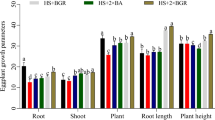Abstract
Viable propagules ofVerticillium albo-atrum were recovered from roots and stems of naturally infected weeds and sunflower cultivars before or after burial in the field and from stems and roots of certain non-infested crops after burial in the field for seven months.Verticillium dahliae was recovered less frequently, then only from the roots ofSolanum nigrum (black nightshade).
Survival of these pathogens after burial for 7 months varied considerably, ranging from 38 to 58% in sunflower stems and from 19 to 235% in roots of weeds.
In stems of weeds and crops which did not contain propagules ofV. albo-atrum before burial, the fungus was recovered consistently after burial, indicating that saphophytic colonization probably occurred during interment.
Resumen
Se recobraron propágulos viables deVerticillium albo-atrum de raíces y tallos, de malezas y cultivares de girasol antes y después de estar enterrados en el suelo, y de tallos y raíces de ciertos cultivos no infectados después de permanecer enterrados por un período de 7 meses.V. dahliae se recobró con menor frecuencia y solamente de raíces deSolarium nigrum.
La sobrevivencia de estos patógenos después de estar enterrados en el suelo por 7 mese mostró una variación considerable con valores que oscilaron del 38 al 58% en tallos de girasol y del 19 al 235% en raíces de malezas.
V. albo-atrum fue frecuentemente obtenido de tallos de malezas y cultivos que habían estado enterrados por un tiempo en el suelo, los cuales no contenian propágulos en al momento de ser enterrados. Esto indica que durante el período que permanecieron bajoierra, existió colonización saprofítica de los mismos.
Similar content being viewed by others
Literature Cited
Boyd, O.C. 1950. Verticillium wilt of potato. Plant Dis Rep 34:339–340.
Evans, G., S. Wilhelm and W.C. Snyder. 1967. Quantitative studies by plate count of propagules of the Verticillium wilt fungus in cotton field soils. Phytopathology 57:590–594.
Hall, R. and L.V. Busch. 1971. Verticillium wilt of Chrysanthemum: colonization of leaves in relation to symptom development. Can J Bot 49:181–185.
Harrison, M.D. 1976. The effect of barley straw on the survival ofVerticillium albo-atrum in naturally infested field soils. Am Potato J 53:385–394.
Jordan, V.W.L. 1971. Estimation of the distribution ofVerticillium populations in infected strawberry plants and soil. Plant Pathol 20:21–24.
Keyworth, W.G. 1952. Verticillium wilt of potatoes in Connecticut. Plant Dis Rep 36: 16–17.
Lacy, M.L. and C.E. Horner. 1966. Behavior ofVerticillium dahliae in the rhizosphere and on roots of plants susceptible, resistant and immune to wilt. Phytopathology 56:427–430.
Martinson, C.A. and C.E. Horner. 1962. Importance of non-hosts in maintaining the inoculum potential ofVerticillium. Phytopathology 52:742. (Abstr.).
Oshima, N., C.H. Livingston and M.D. Harrison. 1963. Weeds as carriers of two potato diseases in Colorado. Plant Dis Rep 47:466–469.
Powelson, R.L. and S.S. Patil. 1963. Influence of oat and alfalfa residues on soil respiration, fungistasis and survival ofVerticillium albo-atrum. Phytopathology 53:1141. (Abstr.).
Sackston, W.E. and J.E. Martens. 1959. Dissemination ofVerticillium albo-atrum on the seeds of sunflower (Helianthus). Can J Bot 37:759–768.
Sewell, G.W.F. and J.F. Wilson. 1958. Isolates ofVerticillium albo-atrum from weeds. Rept E Mailing Res Stan 1957:126–128.
Slattery, R.J. 1981. Inoculum potential of Verticillium-infested potato cultivars. Am Potato J 58:135–142.
Tachibana, H. 1971. Virulence ofCephalosporium gregatum andVerticillium dahliae in soybeans. Phytopathology 61:565–568.
Wilhelm, S. 1951. Effect of various soil amendments on the inoculum potential of the Verticillium wilt fungus. Phytopathology 41:684–690.
Author information
Authors and Affiliations
Additional information
Project financed in part by the Minnesota Potato Certification Agency.
Paper No. 11,670, Scientific Journal Series, Minnesota Agricultural Experiment Station, St. Paul, MN 55108.
Rights and permissions
About this article
Cite this article
Slattery, R.J. Inoculum potential of Verticillium species in crop and weed residues overwintering in infested soil. American Potato Journal 60, 47–53 (1983). https://doi.org/10.1007/BF02853547
Received:
Issue Date:
DOI: https://doi.org/10.1007/BF02853547




